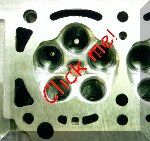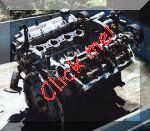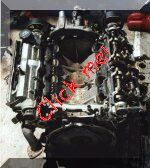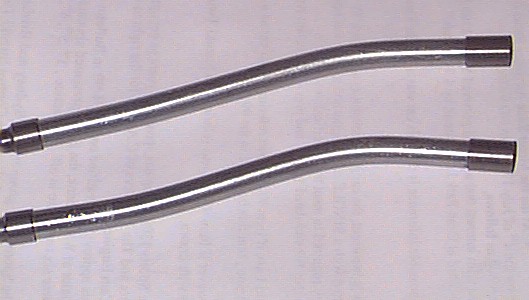
Welcome, from sunny Australia!
More ...
Why a Four Valve Head is so much better
than a Two Valve
(and why a push-rod engine is landfill
;) )

More ...
Why a Four Valve Head is so much better
than a Two Valve
(and why a push-rod engine is landfill
;) )
So what DO I like about V-8's, two valves,
and push-rods?
The packaging (shape) of the V-8 is very
good - It's by far the best configuration of an engine with more than
four cylinders, as it takes up the least amount of room and tends to
have less vibration than an in-line engine. I also reckon they sound
just lovely when revved hard, such as the Aussie 5 Litre Touring Car
series, or Nascar's, etc. This is, of course, purely a function of the
number of cylinders, and nothing to do with the valve actuation. FWIW,
one of the best sounding engine's I've ever heard was a small block
Chevy with a 'flat plane' crank in a speedway Sprint Car.
One of the best mass production engines
around is the Toyota Lexus V-8, which is 4
litres, has four camshafts, and four valves per cylinder. It's a lot
like two Toyota 3SGE's joined together at an angle, as they share
similar bores & strokes. The engine is used in the luxury Lexus car,
and also in the more sporty Soarer. It's built so it has good torque at
all revs, and also so it has very little vibration. Because of this it's
down on power compared to what it could be, and I reckon with some minor
mods it could make an easy 100hp per litre, or 400hp. To get 400hp out
of a Ford/Holden/Chevy 5 litre V-8 isn't hard, but they would be far
less pleasant to drive and use a lot more fuel as well.
As for two valve engines - especially
push-rod ones - the only time I want to see them is in a museum, or on a
chain with a boat at the other end!
The particular case of the Suzuki GTi
and the 3K Corolla
Some years ago, it was suggested that the
Suzuki Swift GTi (or sometimes called the Cultus in Japan) 1300cc engine
would make a good addition to the available engines for the Sports 1300
racing cars in Australia. The rules then only allowed for a single cam
two valve engine, so ultimately there would have to be a rule change to
allow the Suzuki's to be used.
To cut a very long and irrelevant story
short, the new engine was approved on 1-1-1999, and since then a number
of cars have swapped over to the modern twin cam engines. Before this,
basically all the cars used either Toyota Corolla 3K or Datsun A12
push-rod engines, with the average one making 135hp at a maximum rpm of
~8,500 or so. (Note that a few people used Ford 1300cc SOHC's, and there
were also a couple of VW Golf 1300's. The Golf's, if built well, had a
big power advantage, but only one or two people really pursued them)
To keep them reliable, they needed to be
rebuilt every year, ie, new con rod bolts, new piston rings, refurbish
the head, etc, at a cost of about Aus$500 or so. Whenever the head is
refurbished, a small amount is skimmed off it to ensure a nice, flat
sealing surface. This means a limited number of rebuilds before needing
a new head, as they are very thin to begin with - due to the high
compression ratio - and so after about five rebuilds or so, the head
must be replaced with a new one. The cost of a new head to be prepared
to full race specs is over $1,000, so it's certainly a consideration for
costs.
I ran a 3K Corolla for a number of years,
and the only real trouble I ever had with it was the valve gear, ie, it
occasionally had a push-rod fail, a valve spring retainer let go, etc.
Fortunately, I never dropped a valve into the top of a piston, but I
think it was just a matter of time.
When the Suzuki twin cam proposal was first
mooted, my Father and I built up one to the same standard of preparation
as the old 3K, ie, the costs were about the same. I was not the least
bit surprised with the power figures that came out though ... I reckon
that that engine had a good 170hp to 180hp, and it ran quite happily to
10,000 rpm. So, I had a HUGE advantage over the 135hp 3K's & A12's!
The car went like a blur, and naturally I was pretty happy about
this. ;)
This is about the point where the naysayers
started to make a lot of noise, and after a little thought we agreed
with them - If an unrestricted Suzuki was allowed into the class, all
the single cam engines would be made obsolete overnight - At great
expense to the owners!
So, it was decided to make a Suzuki with
135hp to be a 'parity engine' to the 3K's & A12's. It ended up being
rather surprising how little work had to be done to the Suzuki to
get it to make 135hp - I'll give the specs below.
| Suzuki Swift GTi race engine |
3K Corolla race engine | |
| Compression ratio |
10.25:1, can use regular pump fuel | 12.0:1 up to ~13:1, requires high-octane race fuel |
| Rev limit | 8,000, by an electronic limiter | No limit, but often unreliable above 8,500 rpm |
| Camshaft specs | 270° duration, 0.355" lift required | Unrestricted, usually about 320° duration 0.440" lift |
| Cost to prep head | Approx Aus$300 - $500 | Approx Aus$1,000 - $2,000 |
| Expected life between rebuilds | 5+ years | 1 year |
(Note that the above figures are based on my experiences with both engine types. I have been very successful with both types, so I believe that I am qualified to comment on them.)
So there you have the details - To get
the same amount of power, the twin cam engine is basically only a warmed
up road engine, whilst the 3K is a highly stressed full-race engine.
Note that with the three main restrictions
of compression ratio, specific camshaft, and rev limit, it is very
difficult to get more power from the twin cam, so the restrictions are
quite effective. You can do pretty much what you like with the valve
sizes and head porting, etc, and you'll not really get any more from
them, only shift the usable power band around.
Five Valve Heads
There's a few companies that make engines
that have three inlet valves and two exhausts, giving five valves in
total. Since we've clearly found out that four valves are much better
than two, would not five valves be even better? - Not really - Yes, you get even more valve open
area, and yes,
you have even less inertia per inlet valve, but
there are problems with the airflow into the combustion chamber and
also the reduced size of the squish areas. Squish areas are an
important factor in producing good power and it's very difficult to get
decent-sized ones into a five-valve chamber.
So, they in fact don't make as much power
as a good four valve head can - Case in point being the efforts of the
Formula One engineers, who tried for a number of years to get the five
valve heads working, but always ended up going back to the four valve
versions.
One good example of a road going five valve
engine is the last of the naturally aspirated 4AGE 1600cc twin cams,
made by Toyota. Here's a pic of the combustion chamber of one -

Summary
The above specs are possibly the best way to
demonstrate the differences between a modern twin cam and an old
fashioned push-rod engine. 100hp per litre is very, very easy to get out
of the twin cam, and relatively expensive & short lived from the old
engine. It's no different at all for engines of any size - though big,
as in 4+ litres, twin cam engines are hard to find, so the 5 litre V-8's
still tend to dominate the big engine scene. It's really a shame, as I
think you'll agree that with modern engineering it would be quite
possible to have a 500hp 5 litre V-8 these days that would meet all the
emission criteria, be even more driveable than the old types, and
generally be a heck of a lot more fun than the old types.
(Like the stupidly powerful 600hp odd BMW
V-12 six litre engine, as used in McLaren F1 supercar)
I still personally prefer smaller
engines, as all of my cars are relatively lightweight and also don't
have the room for a physically big engine. I think that the best way to
go is to use a turbo on a small engine if you want more power, as it
combines the best of both worlds - when driving 'normally', you have a
small engine, but when driving hard the extra air makes the engine
behave like a big one, so you can get the fuel economy of a small engine
but still have the performance of a big one. But turbo's are another
story.
Speaking of V-8's ...
I guess this is proof that I'm not biased -
Here's a picture of my latest engine puchase, a Toyota 1UZ-FE V-8. They
come standard with a six bolt bottom end (that's six bolts for each main
bearing cap), quad overhead camshafts, twin knock sensors, and have an
alloy block & heads. It's going to be going into the back of my
Dad's Sport Car.


Some real-world figures
...
This is an extract from a friend of mine, Dave
Andrews, about this very subject. He's what he had to say about
some dyno runs that he did -
"First off I agree with most of what Bill
has said, 4 valve engines simply allow better cylinder filling at all
RPM, this translates to improved BMEP and therefore increased torque and
BHP throughout the rev range. I would say that a 4 valve engine in
aspirated form, developed properly will make about 90ft/lb per litre
tops and can sustain most of this for around 50-55% of its rev range, an
8 valve engine developed properly will make no more than 82ft/lb per
litre and can sustain most this for no more than 40-45% of its power
band. This means that a stonking 4 valve engine will be far more
flexible and have a wider torque envelope that an 8 valve.. end of
story, where you choose to make that torque is up to you.
Effective cylinder filling at high RPM (and
therefore big BHP) comes at a price on an 8 valve engine, the price is
wild cams and lots of overlap, these destroy low down torque. 16 valve
engines have inherently better cylinder filling because of increased
valve curtain area, to extract greater power requires less cam duration
and less overlap than with an 8 valve, this allows better retention of
the engines low down torque characteristics.
I've run my current engine in 8 valve and 16
valve form, both times running relatively enormous cams (8v 326deg, 16v
302deg) with ultra big valve heads and 48 webers, the 16 valve version
produces 70BHP more and comes on cam 1500RPM earlier, at 2500RPM the 16
valve has *twice* the torque of the 8 valve.
Peak torque on the 8 valve was 155ft/lb, on
the 16 valve 179ft/lb. From 3500 to 8300 I have over 85% of maximum
torque on the 16 valve, on the 8 valve torque hits 85% of maximum at
4400 and drops below again at around 7200. Thats why I changed to 16
valve..
Here is a real example from a big rolling
road day at Walkers workshop on Sunday 15th, two engines, one an 8 Valve
'Kent' Crossflow, 1780cc, fully worked big valve head, 296 degree cam 40
Webers and 4->1 exhaust, the other a 16V Rover K series 1788cc,
standard head, standard plenum, 268 degree cams, 4-2-1 exhaust.
Both engines made around 146BHP (xflow 145,
K series 147)
The following figures are torque in ft/lbs
| RPM | 8v | 16v |
| 1500 | 45 | 56 |
| 2000 | 68 | 91 |
| 2500 | 101 | 130 |
| 3000 | 112 | 133 |
| 3500 | 112 | 129 |
| 4000 | 111 | 132 |
| 4500 | 126 | 140 |
| 5000 | 129 | 136 |
| 5500 | 130 | 134 |
| 6000 | 126 | 126 |
| 6500 | 112 | 118 |
| 7000 | 99 | 108 |
So there you go - ALL my engines are twin cams, and I'm never turning back.
'Cept BACK to
the previous page. :)

Say goodbye to the push-rods ... ;)
(ex-3K Corolla racing push-rods - modified
from alloy VW units)
Back to the Index page
Page & contents where applicable © Bill Sherwood